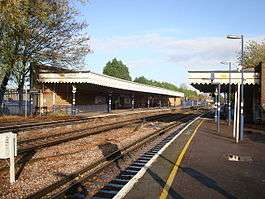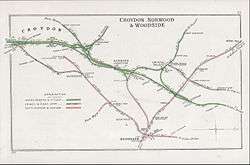New Beckenham railway station
| New Beckenham | |
|---|---|
 | |
 New Beckenham Location of New Beckenham in Greater London | |
| Location | New Beckenham |
| Local authority | Bromley |
| Managed by | Southeastern |
| Station code | NBC |
| DfT category | E |
| Number of platforms | 2 |
| Accessible | Yes [1] |
| Fare zone | 4 |
| National Rail annual entry and exit | |
| 2007–08 |
|
| 2008–09 |
|
| 2009–10 |
|
| 2010–11 |
|
| 2011–12 |
|
| 2012–13 |
|
| 2013–14 |
|
| 2014–15 |
|
| Railway companies | |
| Original company | Mid-Kent Railway |
| Pre-grouping | South Eastern and Chatham Railway |
| Post-grouping | Southern Railway |
| Key dates | |
| 1 April 1864 | Opened |
| 1866 | Resited north |
| Other information | |
| Lists of stations | |
| External links | |
| WGS84 | 51°24′59″N 0°02′05″W / 51.4164°N 0.0348°WCoordinates: 51°24′59″N 0°02′05″W / 51.4164°N 0.0348°W |
|
| |
New Beckenham railway station serves Beckenham in the London Borough of Bromley in south east London, in Travelcard Zone 4. The station and all trains serving it are operated by Southeastern.
History
Early years (1857-1922)
The Mid Kent line was built by the Mid-Kent and North Kent Junction Railway (MK&NKJR) and was opened on 1 January 1857 as far as Beckenham Junction (although it was not technically a junction as the West End of London and Crystal Palace Railway’s line did not open until 3 May 1858).
From opening the line was worked by the South Eastern Railway (SER).
Seven years later the MK&NKJR built an extension from a new junction station at New Beckenham to Croydon (Addiscombe Road) which again was operated by the SER. This first short-lived station was located immediately south of the junction and may have had platforms on the 1857 and 1864 lines. Two years later in October 1866 the current station built just north of the junction was opened.[3][4]
Between 1870 and 1880 new spacious villas were laid out on the Cator estate attracting new business to the railway. The Elmers End – Hayes section was built by the West Wickham & Hayes Railway, but was sold to the South Eastern Railway on opening day, 29 May 1882.[Note 1]
Almost all services from the station have terminated at Charing Cross or Cannon Street stations but between 1880 and 1884 a service worked between Croydon (Addiscombe Road) calling all stations to New Cross and then via a connection to the East London Line and terminating at Liverpool Street station.[5]
In 1898 the South Eastern Railway and its bitter rivals the London Chatham and Dover Railway agreed to work as one railway company under the name of the South Eastern and Chatham Railway and New Beckenham became an SECR station.
The station was rebuilt in 1904. At this time a middle road was provided, level crossings were replaced by road bridges and a tiled subway and a new 50 lever signal box provided. At this time as well as through workings there were services that terminated or attached to other London bound trains at New Beckenham. The short link to Beckenham Junction was also served by a shuttle service from New Beckenham.[6][7]
Southern Railway (1923-1947)
Following the Railways Act 1921 (also known as the Grouping Act), New Beckenham became a Southern Railway station on 1 January 1923.
The Mid-Kent line was electrified with the (750 V DC third rail) system and electric services commenced on 28 February 1926. Early electric services were worked by early Southern Railway 3-car Electric Multiple Unit trains often built from old SECR carriages.
The middle line was removed in 1929.[8]
British Railways (1948-1994)
After World War II and following nationalisation on 1 January 1948, the station fell under the auspices of British Railways Southern Region.
Colour light signalling was introduced between Ladywell and New Beckenham on 4 April 1971 with signalling being controlled by the signal box at New Beckenham. South of the station semaphore signalling remained until 28 September 1975 when the control of the signalling was transferred to London Bridge signalling centre and New Beckenham signal box (a two-storey structure located at the end of the down platform) was closed.[9][10]
Upon sectorisation in 1982, three passenger sectors were created: InterCity, operating principal express services; and London & South East (renamed Network SouthEast in 1986) who operated commuter services in the London area.[11]
The spur between New Beckenham and Beckenham Junction (the original 1857 route) was reduced to single track in 1987 with a stabling siding replacing the lifted line. Regular services had not been run over the line for many years but in 1990s a Cannon Street-Lewisham-New Beckenham- Bromley South-Orpington briefly operated.[12]
The privatisation era (1994-Present Day)
Following privatisation of British Rail on 1 April 1994 the infrastructure at New Beckenham station became the responsibility of Railtrack whilst a business unit operated the train services. On 13 October 1996 operation of the passenger services passed to Connex South Eastern who were originally due to run the franchise until 2011.
Following a number of accidents and financial issues Railtrack plc was sold to Network Rail on 3 October 2002 who became responsible for the infrastructure.[13][14]
On 27 June 2003 the Strategic Rail Authority decided to strip Connex of the franchise citing poor financial management and run the franchise itself.[15][16] Connex South Eastern continued to operate the franchise until 8 November 2003 with the services transferring to the Strategic Rail Authority's South Eastern Trains subsidiary the following day.
On 30 November 2005 the Department for Transport awarded Govia the Integrated Kent franchise. The services operated by South Eastern Trains transferred to Southeastern on 1 April 2006.
Services
1912
In 1912 the daily down services to New Beckenham consisted of:[17]
| From | To | Route | Number per day | Notes |
|---|---|---|---|---|
| Charing Cross | Beckenham Junction or Addiscombe | via Cannon Street & London Bridge | 10 | Train splits at New Beckenham |
| Charing Cross | Addiscombe | via Cannon Street and London Bridge | 2 | |
| Charing Cross | Addiscombe | via London Bridge | 2 | |
| Charing Cross | Beckenham Junction | via London Bridge | 2 | |
| Charing Cross | Addiscombe/Beckenham Junction & Orpington | via London Bridge | 1 | Train splits at New Beckenham |
| Cannon Street | Beckenham Junction & Orpington | via London Bridge | 12 | |
| Cannon Street | Addiscombe | via London Bridge | 4 | |
| Cannon Street | Beckenham Junction | via London Bridge | 3 | |
| Cannon Street | Selsdon | via London Bridge | 1 | |
| Cannon Street | Edenbridge | via London Bridge | 1 | |
| St Pauls (Blackfriars) | Beckenham Junction | via London Bridge | 1 | Terminates |
2016
The typical off peak train service per hour is:[18]
- 2 northbound, calling at all stations to Cannon Street
- 2 northbound, calling at all stations to Ladywell then fast to Waterloo East and Charing Cross
- 4 southbound, calling at all stations to Hayes on the Hayes line
On Sundays, there is a half-hourly service to Cannon Street & Hayes.

| Preceding station | |
Following station | ||
|---|---|---|---|---|
| Lower Sydenham | Southeastern Hayes Line |
Clock House | ||
| Southeastern Limited Service |
Beckenham Junction | |||
Layout
| Southeastern towards Charing Cross, Cannon Street | |
| Southeastern towards Hayes | |
Connections
London Buses route 352 serve the station.
Notes
- ↑ The current Hayes service (2016) which serves the station uses the 1857 line to New Beckenham, the 1864 line to Elmers End and the 1882 line to Hayes.
References
- ↑ "London and South East" (PDF). National Rail Enquiries. National Rail. September 2006. Archived from the original (pdf) on 6 March 2009.
- 1 2 3 4 5 6 7 8 "Station usage estimates". Rail statistics. Office of Rail Regulation. Please note: Some methodology may vary year on year.
- ↑ Jackson, Alan A (1999). London's Local Railways (2nd ed.). Harrow Weald: Capital Transport Publishing. pp. 37–40.
- ↑ Butt, R.V.J. (1995). The Directory of Railway Stations. Yeovil: Patrick Stephens Ltd. p. 168. ISBN 1-85260-508-1. R508.
- ↑ Mitchell, Vic; Smith, Keith (1996). East London Line. Midhurst, UK: Middleton Press. p. 5. ISBN 1 873793 80 4.
- ↑ Mitchell, Vic; Smith, Keith (September 1993). London Bridge to Addiscombe. Midhurst, UK: Middleton Press. p. 56. ISBN 1 873793 20 0.
- ↑ Jackson, Alan A (1999). London's Local Railways (2nd ed.). Harrow Weald: Capital Transport Publishing. p. 45.
- ↑ Mitchell, Vic; Smith, Keith (September 1993). London Bridge to Addiscombe. Midhurst, UK: Middleton Press. p. 55. ISBN 1 873793 20 0.
- ↑ Jackson, Alan A (1999). London's Local Railways (2nd ed.). Harrow Weald: Capital Transport Publishing. pp. 47, 48.
- ↑ Mitchell, Vic; Smith, Keith (September 1993). London Bridge to Addiscombe. Midhurst, UK: Middleton Press. pp. 56–58. ISBN 1 873793 20 0.
- ↑ Thomas, David St John; Whitehouse, Patrick (1990). BR in the Eighties. Newton Abbot: David & Charles. ISBN 0-7153-9854-7.
- ↑ Mitchell, Vic; Smith, Keith (September 1993). London Bridge to Addiscombe. Midhurst, UK: Middleton Press. p. 58. ISBN 1 873793 20 0.
- ↑ Network Rail closer to Railtrack takeover BBC News, 1 April 2016
- ↑ "Accounting for Producer Needs: The case of Britain's rail infrastructure" (PDF). Centre for Management and Organisational History. p. 18. Retrieved 1 April 2016.
- ↑ "BBC NEWS - UK - England - Train firm loses franchise". BBC News. 27 June 2003. Retrieved 1 April 2016.
- ↑ Basher Bowker pulls the plug on Connex The Telegraph 29 June 2003
- ↑ Jackson, Alan A (1999). London's Local Railways (2nd ed.). Harrow Weald: Capital Transport Publishing. p. 46.
- ↑ Table 203 National Rail timetable, May 2016
External links
| Wikimedia Commons has media related to New Beckenham railway station. |
- Train times and station information for New Beckenham railway station from National Rail